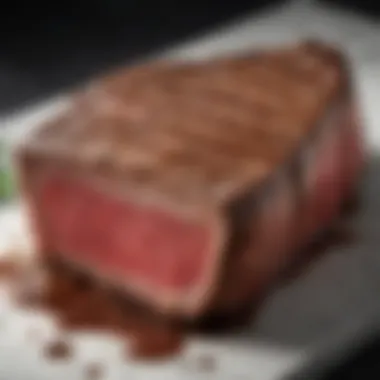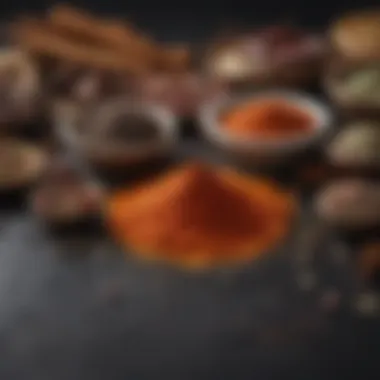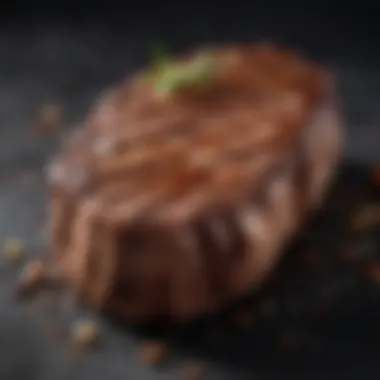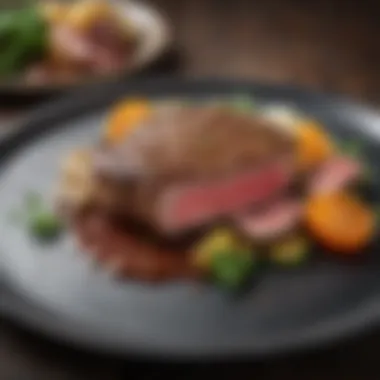Master the Art of Grilling Steak: Tips & Techniques


Intro
Grilling steak is both an art and a science. Mastering the techniques involved leads to enhanced flavor profiles and a perfected dining experience. This comprehensive guide delves into the choice of cuts, preparation methodology, and the grilling process itself, providing insights that can benefit both beginners and experienced chefs alike. Whether for a quick family meal or a culinary showcase, knowing how to grill steak with precision is invaluable for anyone in the kitchen.
Recipe Overview
Catchy Name: Perfectly Grilled Steak
Yield: Serves 4
Preparation Time: 15 minutes
Cooking Time: 15–20 minutes
Difficulty Level: Medium
Main Ingredients:
- High-quality ribeye steak or sirloin
- Sea salt
- Freshly ground black pepper
- Olive oil
- Optional marinade or seasoning
Step-by-Step Instructions
To grill the perfect steak, meticulous preparation and clear instructions are essential. Here’s how to go about it:
- Selecting the Steak: Choose a cut that visibly marbled. Ribeye or sirloin are great options.
- Preparation: Remove the steak from the fridge 30 minutes prior to grilling to reach room temperature. This helps achieve even cooking throughout.
- Seasoning: Generously season with sea salt and pepper, or apply a marinade if desired. A good rub can enhance flavor.
- Preheating the Grill: Ensure the grill is preheated to high heat before placing the steak on.
- Grilling: Place the steak on the hottest part of the grill. Grill for 4 to 5 minutes without moving the steak. Flip and repeat for desired doneness.
- Resting: After grilling, let the steak rest for 5 to 10 minutes before slicing. This allows juices to redistribute, making it more tender and juicy.
Time-Saving Strategies
- Use back-to-back grilling for multiple steaks to save time.
- Pair grilling with prepping side dishes to maximize efficiency.
Nutritional Information
The delightful grilled steak can be both satisfying and nutritious:
- Calories per Portion: Approximately 350–400 calories.
- Proteins: About 26–32 grams.
- Fats: Roughly 25–30 grams.
- Carbohydrates: Minimal, generally around 0 grams.
This steak is particularly rich in iron and vitamin B12, which are crucial for maintaining energy levels and supporting overall health.
Quick Cooking Tips
Getting the best results requires insight:
- Kitchen Gadgets: Consider using a meat thermometer to monitor the cooking precision.
- Multitasking: While steaks are grilling, start preparing sides such as grilled vegetables.
- Healthier Alternatives: Swap regular steak for lean cuts like flank or tenderloin for a lighter option.
Related Recipes & Variations
Grilled steak can pair excellently with various complementary dishes. Consider these options:
- Garlic mashed potatoes make for a delectable side.
- A fresh garden salad brightens up the meal.
- A chimichurri sauce over the steak adds a creative twist.
For specific dietary adaptations, consider using gluten-free marinades and serving alongside vegetables for a lighter plate.
Healthy and flavorful doesn’t have to be complicated. Elevating grilling techniques transforms simple ingredients into memorable meals.
Mastering the art of grilling steak with this detailed guide sets you up for culinary success. Experiment with different flavors and techniques to make it your own.
Understanding Steak Cuts
Understanding steak cuts is essential for anyone interested in mastering the art of grilling. Different cuts of steak come with specific characteristics that affect flavor, tenderness, and overall cooking methods. A good grasp of these cuts helps in making informed decisions that contribute greatly to the grilling process and final presentation.
Selecting the right cut can make the difference between a delicious meal and a mediocre one. Various steak options like Ribeye and Sirloin each offer unique taste profiles and textures. This could significantly enhance or alter the final results of your grilling efforts.
Different Types of Steak
Ribeye
Ribeye is well-known for its marbling and rich flavor. The even distribution of fat throughout the cut contributes to a juicy steak that remains tender when grilled. People often turn to Ribeye because its taste is enhanced with simple seasonings — the beef’s natural flavors shine through. However, this cut is typically more expensive than others, which can be a drawback for some.
Sirloin
Sirloin is a leaner cut that still provides good flavor and tenderness, making it a popular option. Its balance of taste and price points makes it highly accessible for everyday grilling. While Sirloin might not boast the same level of richness as Ribeye, it has a firmer texture that some prefer. Regardless, choosing Sirloin means paying attention to cooking rather than simply relying on fat content for juiciness.


Filet Mignon
Filet Mignon is known for its extreme tenderness, often regarded as the most luxurious steak cut. The subtle flavor doesn’t overwhelm the palate, allowing for pairing with a variety of sauces and sides. The challenge with Filet Mignon lies in its cost, as it tends to be on the high end of steak prices. It requires careful cooking to avoid overcooking, as it lacks the moisture found in fattier cuts.
T-bone
The T-bone combines two steak cuts in one: the flavorful Striploin and the tender Tenderloin. This unique structure offers the best of both worlds, providing versatility in cooking methods. However, T-bones can be bulky and may require skillful grill handling to ensure even cooking. Not everyone appreciates the sizeable bone remaining, which can impact serving sizes.
Flank Steak
Flank Steak is popular for its bold flavor, often used in specialized preparations like fajitas. It is leaner, requiring a bit more attention in cooking to keep it from turning tough. The grain texture promotes specific slicing techniques that maximize tenderness upon serving. Flank steak is generally more affordable and abundant, making it an attractive option for budget-conscious grilling.
Selecting the Right Cut
When it comes to selecting the perfect cut, several factors should be taken into account.
Considerations for Flavor
Flavor considerations involve evaluating the richness and depth each cut provides. The right choice can dramatically alter the final dish’s outcome. Cuts rich in intramuscular fat, such as Ribeye, can deliver more intense flavors and mouthfeel. Leaner cuts may serve well with robust marinades or sides to balance flavors across the board.
Budget and Availability
Budget impacts the choice significantly. Certain holiday seasons can cause fluctuations in steak prices, influencing overall availability at local markets. Sirloin and Flank Steak may generally offer cost-effective grilling options compared to Filet Mignon or T-bones.
Cooking Methods Compatibility
Compatibility with different cooking methods also plays a crucial role. For instance, thinner cuts like Flank Steak benefit from quick high-heat grilling, whereas thicker cuts require time and care to achieve the desired doneness. Understanding these aspects will enhance grilling success and the satisfaction of enjoying a well-grilled steak.
Preparing the Steak for Grilling
Preparing the steak before grilling is a crucial step that can greatly influence the outcome of the final dish. Proper preparation ensures that flavors are maximized and textures improve, leading to a more enjoyable dining experience. This stage includes thawing, drying, and seasoning or marinating the steak, each with distinct techniques and benefits.
Thawing and Drying
Safe Thawing Techniques
Safe thawing techniques contribute significantly to food safety and preserving the quality of steak. The recommended method is to thaw the meat in the refrigerator. This allows the steak to thaw evenly while minimizing the risk of bacteria growth. It usually takes several hours or overnight, but it is the safest choice.
Another viable option is to use cold water immersion. Sealed in plastic, the steak can be submerged in cold water. This method accelerates the thawing process but requires more monitoring to ensure the water remains cold.
Avoid thawing at room temperature. While faster, it can promote the growth of harmful bacteria. Following these safe thawing practices keeps the steak fresh and safe to eat.
Importance of Drying for a Good Sear
Drying plays a key role in achieving a good sear on grilled steak. When meat is wet, it produces steam as it cooks, interfering with the searing process. A proper sear helps lock in juices and promote a desirable texture. After thawing, patting the steak dry using paper towels is ideal to remove excess moisture. This single step ensures that when the steak hits the hot grill, it will develop the perfect crust.
In summary, both techniques of thawing and drying yield substantial results in enhancing the overall quality of grilled steak.
Marinating vs.
Seasoning
Benefits of Marinating
Marinating offers a range of benefits that can enhance the flavor and texture of steak. The process involves soaking meat in a liquid that usually combines an acid (like vinegar or lemon juice), oil, and various seasonings. This not only imparts flavor but also can help tenderize the meat, making it more enjoyable to chew.
Marinating can vary in duration, from just a few hours to overnight. The longer the steak marinates, the more infused flavors it will have. Nevertheless, it’s important not to over-marinate as excessive acid can lead to a mushy texture.
Simple Seasoning Techniques
Simple seasoning techniques focus on enhancing a steak's natural flavor without overwhelming it. Salt and pepper remain the foundation for many cooks. They balance flavor and can elevate the taste without complexities. To season, sprinkle generous amounts of salt on both sides before grilling. Alternatively, garlic powder, onion powder, or even a dash of smoked paprika can add depth.
Using simple oils with herbs or spices before grilling can also enrich the taste. A vinegar-based dressing works too, adding a tangy punch.
Grill Setup and Temperature Control
Grill setup and temperature control are critical for successfully grilling steak. Mastering these aspects can greatly influence the overall cooking experience and the final outcome of the steak. Grilling properly starts with understanding not just the equipment but how it affects the meat’s flavor and texture. Here’s what you should know.
Types of Grills
Gas Grills


Gas grills are a popular choice for their convenience and ease of use. They allow for precise temperature control, essential for achieving the perfect steak sear. One of the main advantages of gas grills is their ability to heat up quickly. This ensures that your steak goes from the refrigerator to the grill in minimal time, reducing prep intensity in busy schedules.
However, a potential disadvantage lies in the flavor. Unlike charcoal grills, gas grills might deliver a slightly less smoky flavor. For those who prioritize ease above all, gas grills stand out as a practical option.
Charcoal Grills
Charcoal grills offer a unique flavor profile that many enthusiasts seek. The method involves burning charcoal, providing that traditional smoky flavor often associated with grilled meats. This feature is a considerable advantage when creating a authentic grilling experience. One key downside, however, is the temperature management; charcoal grilling requires more patience for lighting and regulating heat levels conclusively.
For grilling professionals and serious fans, it’s the depth of flavor achieved through this method that often outweighs these concerns. It brings the rustic aesthetic and intensity which many desire when cooking steak.
Electric Grills
Electric grills are appealing due to their practicality, especially for urban environments where space can be a challenge. They achieve consistent heat without needing to manage fuel sources. The design is compact, often facilitating simple storage in kitchens.
Still, electric grills have their own limitations. They might not reach the high temperatures typical of traditional grills. Therefore, if you're keen on searing, you might obtain lesser results than with the previous options. Their ease of use can position them favorably, particularly for beginners.
Pre-heating the Grill
Determining the Right Temperature
Understanding how to determine the right temperature for breading grilled steaks lays the groundwork for proper cooking techniques. The ideal temperature range usually falls between 450°F and 500°F. This bracket is where you see a nice sear while cooking the inside to the desired doneness.
Getting this right affects how the meat retains juices and flavors. Predominantly, grilling at higher temperatures caramelizes the outside creating a flavorful crust. However, significant caution is necessary over heating levels as surpassing 600°F can easily lead to charring. Balancing these levels while cooking is key to optimal grilling results, enhancing every bite’s satisfaction.
Checking Grill Readiness
Another essential factor in grill setup is confirming readiness. This step tips the scales between a charred exterior and evenly cooked steak. Checking readiness involves using various methods, such as placing your hands above the grill to assess heat intensity.
Other indicators include visual cues, such as heat rising or the grill grates showing signs of oil begin to smoke. This preparation step assures that a perfect steak, both visually appealing and nourishing to the palate, can be achieved with fewer surprises in the cooking process. Proper understanding in this stage allows for a confident grilling session, where anticipation amongst diners is high.
Establishing a keen observation through setup enables less recurring issues, culminating in consistently delicious grilled steaks.
Grilling Techniques
Grilling techniques are fundamentally essential in achieving the perfect steak. It encompasses various methods of temperature control that influence flavor, texture, and overall satisfaction. Understanding these techniques helps cooks, whether amateurs or veterans, enhance their culinary repertoire. It optimizes the grilling process, ensuring that the steak turns out delectably each time.
Direct vs.
Indirect Heat
Direct and indirect heat represent two primary methods of grilling that affect cooking outcomes differently. Each method has its unique applications and appropriate usage contexts, making it vital to know when to employ either.
When to Use Each Method
Utilizing direct heat involves cooking the steak over the flame or heat source, ideal for tender cuts, such as ribeye or filet mignon. This method entails searing, which locks in flavors while developing an appealing crust. On the other hand, indirect heat is used for larger, tougher cuts, such as flank steak. It minimizes the chances of overcooking, enabling thorough cooking without charred exteriors. Selecting either method effectively contributes to perfect doneness while respecting the steak cut’s unique characteristics.
“Understanding when to use each grilling method is crucial for achieving optimal flavor and texture.”
Benefits of Each Technique
The benefits of each technique are notable and yield distinct finishing results. Direct heat imparts strong grill marks and flavor through caramelization. It is beneficial for quick cooking, especially suitable for steaks requiring minimal time on the grill. Conversely, indirect heat provides control over cooking progress, making it easier to ensure the steak reaches the desired internal temperature without compromise at the surface. Both techniques possess advantages, and adeptly combining them elevates overall grilling proficiency.
Grilling Time Guidelines
Properly managing grilling time is integral in achieving ideal steak doneness. Understanding how cooking times correlate with thickness and desired levels can prevent overcooking or undercooking.
Determining Steak Doneness
Recognizing the degrees of doneness—rare, medium rare, medium, medium well, and well done—is pivotal. Each level requires distinct internal temperatures and, by clockwork process, specific approaches to grilling. Relying on appearance alone can be misleading; learning these standards results in achieving preference satisfaction. It highlights the significance of being diligent while monitoring steak during grilling, contributing to overall success period engagement in cooking.
Using a Meat Thermometer
Investing time and emphasis in using a meat thermometer enhances precision considerably. A thermometer provides an accurate reading of internal temperature rather than stripping off the steak or relying on touch indicators. This tool helps to obtain a precise level of doneness, thus improving grilling outcomes. Ensure the thermometer is calibrated correctly, placing it in the thickest part of the steak for maximum effectiveness. This assured method of checking doneness can be the difference between a perfectly cooked steak or a regrettable overdone piece.
Applying the right grilling techniques makes each steak grill like an art piece. It is not just heat and meat; it is curiosity, consideration, and understanding all at once.
Finishing Touches
Finishing touches are crucial for enhancing the overall quality of grilled steak. These elements might seem minor, but they play a significant role in both flavor and presentation. Taking time for these details can enhance the dining experience. Effective finishing touches can transform a well-cooked steak into a remarkable dish that leaves a lasting impression.
Resting the Steak


Resting is the final step after grilling steak. It may seem unnecessary, but it is vital for achieving the best texture and tenderness.
Why Resting is Essential
Resting steak allows fibers to relax. When steak cooks, juices rise to the surface. If you cut into the steak immediately, those juices will spill out, leading to dryness. By allowing the steak to rest, juices redistribute throughout the meat, providing more flavor and moisture. This process ensures a paying-off experience that joins both rulers of quality and consistency. A temperature drop occurs, which does not spoil the flawless cooking you achieved; in fact, it endorses even cooking.
Optimal Resting Time
To achieve the maximum benefit, it is vital to know the optimal time for resting steak. Generally, resting for 5 to 10 minutes inflates flavors well. Larger cuts may need to rest even longer, around 15 to 20 minutes. During this period, the steak temperature typically varies only slightly, preserving warmth while enhancing quality. It plays a significant role in connoisseur dining experiences while preventing meat from loosing internal temperature drastically when cuts are done on the board.
Serving Recommendations
Serving your steak attractively is as vital as choosing the right cut. Attention to presentation can highlight grilling skills and contribute to the enjoyment of the meal.
Plating Suggestions
Plating suggestions help to elevate the presentation to culinary heights. Try placing steaks at an angle on the plate. This touches one joy successfully. Simple garnishes like herbs or vegetables can add color and interest without overwhelming. Using any colorful side can significantly aid single steaks minimizing chaos. Balanced plating maintains a clean look and provides an appetizing view for those at the table.
Complementing Sides and Sauces
Lastly, complementary sides and sauces are foundational elements that enrich the grilled steak. For instance, classic sides like roasted vegetables, mashed potatoes, or grilled asparagus pair harmoniously with many types of steak. Additionally, consider sauces like classic chimichurri, barbecue sauce, or even a simple garlic butter sauce. These choices add depth to your meal; simple sauces enhance palates without overpowering the grilled quality itself. If cooking for guests, think variety beyond main steaks straight; presenting contrasting elements marches toward unpredictable desserts in final glory.
Maintenance of Grilling Tools
Maintaining grilling tools is an often underestimated aspect of the overall grilling experience. Proper maintenance ensures the longevity of your equipment and can significantly influence the quality of your grilled steak. Tools that are well cared for promote hygiene, which is essential for food safety. In addition, tools that function correctly allow for a more enjoyable grilling process.
Cleaning the Grill
Basic Cleaning Techniques
Basic cleaning techniques include removing burnt food residue and grease from the grill grates after each use. This process is crucial as it helps maintain flavor integrity for future cooking sessions. A common method is to use a grill brush made of brass or stainless steel to scrub down the grates. Furthermore, for gas grills, it may be judicious to periodically check and clean the burner tubes as well. This prevents clogs and promotes even cooking.
Importance of Grill Maintenance
Regular grill maintenance is vital for enhancing performance and investment longevity. When grills are ignored, serious issues can arise such as reduced cooking performance or even hazardous situations like gas leaks. Therefore, making maintenance a routine practice saves time and money in the long run. Simple actions like checking hoses, cleaning, and ensuring components are secure improve the grill's overall safety and functionality.
Storing Tools Properly
Avoiding Rust and Damage
Avoiding rust and damage is essential for maintaining the usability of your grilling tools. Tools left outside, unsheltered from the elements are susceptible to corrosion. Traditional storage methods like setting tools on a shelf may invite dust and moisture exposure leading to deterioration. To prevent rust, tools should be cleaned, dried immediately after use, and stored in a cool, dry place. Key characteristics include enhancing tool life and ensuring proper function when needed.
Organizing Your Grilling Tools
Organizing your grilling tools keeps your workspace efficient. Well-organized tools allow for quick access during grilling, reducing preparation time. A clutter-free environment enhances focus and makes the grilling process more pleasant. You might consider additional solutions like tool belts or small storage units where related tools are kept together. Such unique features further simplify the experience and make being a home griller pleasurable.
Tip: Keeping tools organized and properly stored can help prevent the tedious search during spontaneous grilling moments.
Through judicious cleaning, maintenance, and organization, you enhance both your grilling performance and prolong the life of your equipment. Taking these steps contributes to achieving that sought-after perfect steak.
Troubleshooting Common Grilling Issues
Grilling steak can present certain challenges. A successful grilling session requires care in addressing common issues. It is crucial to understand the potential mishaps that may arise. When troubles happen, a swift solution can save the meal and provide a learning experience for improving skills in future sessions. Understanding how to troubleshoot common issues enhances not just your ability but also the pleasure of cooking.
Handling Overcooked Steak
The problem of overcooked steak often arises during grilling. This can result from various factors.
Causes of Overcooking
Overcooking happens when steak is exposed to high heat for too long. A primary reason includes misunderstanding cut thickness. Thin cuts tend to cook faster compared to thicker ones. Lack of experience may lead to misjudging cooking times. Sometimes, external variables such as grill temperature and wind can also contribute. The consequences are significant; overcooked steak loses moisture and becomes tough. It can ruin the steak entirely, leading to dissatisfaction.
Salvaging Techniques
If the steak is already overcooked, not all hope is lost. Certain techniques may offer a chance to recover the meal. One approach is to slice the steak into thin strips and resulting pieces can be combined into salads. This strategy can mask dryness levels by adding sauces or dressings. Alternatively, if herbs or spices were previously used, they might be applied to add moisture. While these methods work, they do have limitations. Salvaging is not a complete fix for the loss of flavor and texture.
Dealing with Flare-Ups
Flare-ups can occur without much warning. Flames can shoot up from the grill due to dripping fat or marinade. Understanding how to manage these flare-ups is essential.
Prevention Strategies
Many solutions assist in minimizing flare-ups during grilling. First, learning to choose cuts with less fat or trimming excessive fat can make grilling much smoother. Additionally, adjusting the grill height as needed can control liquid escape, as well as ensuring the grill is clean. Using indirect grilling techniques for fatty cuts may also help. Implementing these strategies not only reduces fire risks but also serves to enhance the overall control over cooking temperatures.
What to Do in Case of Flare-Ups
If flare-ups still occur, quick intervention is crucial. One approach is to temporarily move the steak to a cooler part of the grill, away from direct flames. Protect the grill with a lid as this can also snuff out flames and absorb soot. Once flames subside, the steak can return to the initial cooking zone. Ensuring safety during flare-ups is key, as overlooking them may lead to safety hazards or burns. Familiarizing yourself with flare control will build confidence while grilling.







